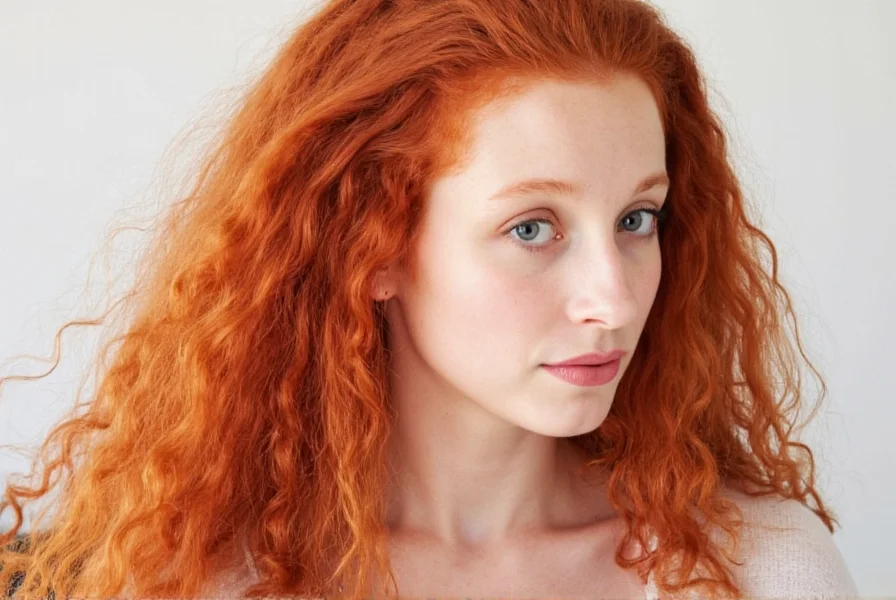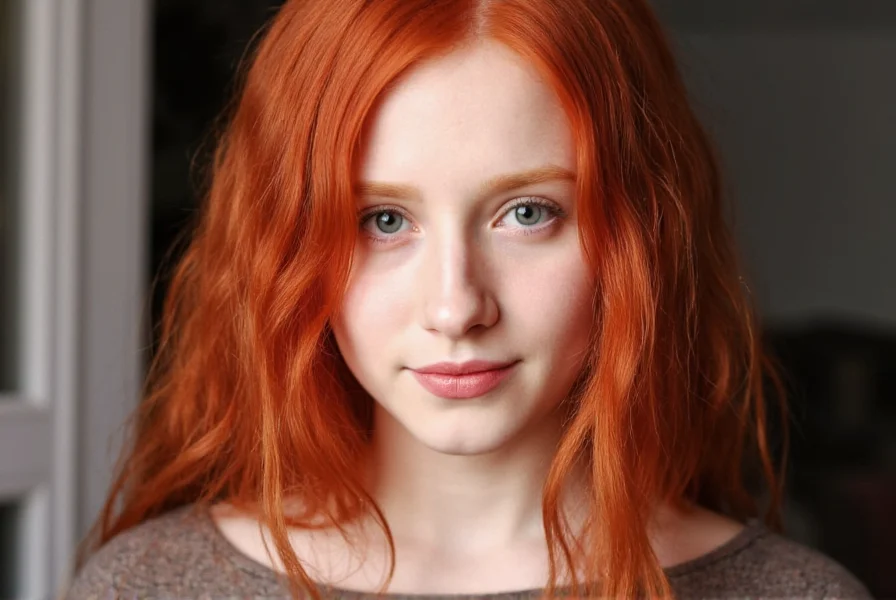Understanding the unique characteristics of natural ginger red hair helps individuals properly care for this rare hair color, which appears in only 1-2% of the global population. This warm-toned redhead variation stands apart from other red hair types through its unmistakable coppery-orange brilliance and specific genetic markers.
Defining True Ginger Hair Characteristics
While often used interchangeably with "redhead," ginger hair represents a specific spectrum within the redhead family. True ginger hair features:
- A vibrant copper-orange base with pronounced golden undertones
- A warm spectrum that ranges from light copper to deep burnt orange
- Distinct separation from auburn (which contains brown undertones) and strawberry blonde (which has more yellow)
- Typically paired with fair, freckled skin and light-colored eyes
The precise shade varies based on the specific MC1R gene variants present. Those with the strongest ginger expression often have hair that appears almost luminous in sunlight, creating a striking visual effect that sets it apart from other redhead variations.
The Genetic Science Behind Ginger Hair
Ginger red hair results from specific variants in the MC1R (Melanocortin-1 receptor) gene located on chromosome 16. This recessive genetic trait affects melanin production in the following ways:
| Genetic Factor | Effect on Hair Color | Prevalence |
|---|---|---|
| MC1R gene variants | Reduces eumelanin (brown/black pigment) | Recessive trait requiring two copies |
| Pheomelanin production | Increases red/yellow pigment | Primary pigment in ginger hair |
| Hair follicle chemistry | Creates warm coppery reflection | Distinguishes from cooler red tones |
Unlike other hair colors, ginger isn't a single genetic expression but rather a spectrum influenced by multiple MC1R variants. Research shows over 30 different MC1R mutations can produce red hair phenotypes, with the strongest ginger expressions occurring when an individual inherits two copies of specific variants.
Specialized Care for Ginger Hair Maintenance
Ginger red hair requires specialized care due to its unique pigment structure. The pheomelanin that creates ginger's distinctive color is more fragile than eumelanin, leading to faster fading and color degradation. Key care considerations include:
Color Preservation Strategies
Preserving vibrant ginger hair color involves addressing its specific vulnerabilities:
- Sulfate-free cleansing: Traditional sulfates strip the delicate pheomelanin pigment more aggressively than other hair colors
- Copper-infused products: Counteract greenish tones that develop as ginger fades in chlorinated water
- UV protection: Ginger hair fades 30-50% faster in sunlight than darker hair colors due to lower eumelanin content
- Cool water rinsing: Hot water opens cuticles, accelerating color loss in ginger hair
Managing Ginger Hair Fading Patterns
Understanding how ginger hair fades helps maintain its distinctive warmth. Unlike other red hair types that may turn brassy, ginger typically follows this fading pattern:
- Bright copper-orange (original ginger tone)
- Golden-orange (early fading stage)
- Muted copper (mid-fading stage)
- Pale yellow-orange (advanced fading)
- Greenish-yellow (final fading stage in chlorinated environments)
Regular use of color-depositing conditioners with warm orange tones can help maintain ginger's characteristic vibrancy between color treatments.
Common Ginger Hair Challenges and Solutions
Those with natural ginger red hair face specific challenges that require tailored solutions:
Sun Exposure Sensitivity
Ginger hair's low eumelanin content provides minimal natural UV protection. This results in:
- Accelerated color fading (up to 50% faster than darker hair)
- Increased risk of protein damage from UV exposure
- Higher likelihood of developing greenish tones in pool water
Solution: Daily UV-protectant sprays containing copper compounds help maintain ginger's warm tones while protecting the hair structure.
Color Matching Difficulties
When coloring non-ginger hair to achieve ginger tones, professionals face challenges matching the natural warmth. Box dyes often create:
- Artificial-looking orange tones
- Inconsistent results across different hair textures
- Rapid fading to undesirable yellow-orange
Natural ginger-haired individuals should avoid at-home color corrections, as their unique pigment composition reacts differently to chemical treatments than other hair colors.

Embracing Your Natural Ginger Beauty
While ginger red hair requires specialized care, its distinctive beauty has gained increasing appreciation. Understanding your specific ginger variation helps optimize care:
- Light ginger: Focus on maintaining golden undertones with brass-reducing treatments
- Medium copper ginger: Prioritize warmth preservation with orange-toned conditioners
- Deep ginger: Balance richness with treatments that prevent darkening to auburn
Genetic testing services now identify specific MC1R variants, helping ginger-haired individuals understand their unique color properties and optimal care approaches. This personalized approach to ginger hair care represents a significant advancement beyond one-size-fits-all red hair recommendations.
Frequently Asked Questions About Ginger Red Hair
What makes ginger hair different from other red hair types?
Ginger hair specifically refers to the warm copper-orange spectrum of red hair with pronounced golden undertones, lacking the brown tones found in auburn or the yellow dominance of strawberry blonde. It's characterized by its vibrant, almost luminous quality in natural light and results from specific MC1R gene variants that maximize pheomelanin production while minimizing eumelanin.
Why does ginger hair fade faster than other hair colors?
Ginger hair fades faster because it contains predominantly pheomelanin (red/yellow pigment) rather than eumelanin (brown/black pigment). Pheomelanin molecules are structurally less stable and more susceptible to breakdown from UV exposure, heat, and chemical treatments. This causes ginger hair to lose its vibrant copper tones 30-50% faster than darker hair colors when exposed to the same environmental factors.
Can non-redheads achieve authentic ginger hair color?
Achieving authentic ginger tones is challenging for non-redheads because natural ginger results from specific genetic factors affecting hair's internal structure and porosity. While professional colorists can create ginger-like shades, these often lack the multidimensional warmth of natural ginger and fade to undesirable tones more quickly. Box dyes rarely produce authentic ginger results and typically create artificial-looking orange tones that fade unevenly.
What's the difference between ginger and copper hair?
While often confused, ginger and copper hair represent different points on the redhead spectrum. Ginger features a brighter, more orange-dominant tone with golden undertones, while copper has a deeper, more reddish base with subtle brown undertones. True ginger maintains its warm orange reflection in all lighting conditions, whereas copper hair shows more variation, appearing richer in some lights and more brownish in others. Ginger also typically occurs with fairer skin and more freckles than copper hair.
How can I prevent my ginger hair from turning green in pools?
To prevent greenish tones in ginger hair from chlorinated water, apply a protective barrier before swimming using products containing copper compounds that counteract the green reaction. Wet hair thoroughly with clean water first, then apply a leave-in conditioner or specialized swim cap. Immediately after swimming, use a chelating shampoo designed for red hair that removes mineral buildup without stripping color. Regular use of copper-infused conditioners helps maintain ginger's warm tones while neutralizing potential green undertones.











 浙公网安备
33010002000092号
浙公网安备
33010002000092号 浙B2-20120091-4
浙B2-20120091-4